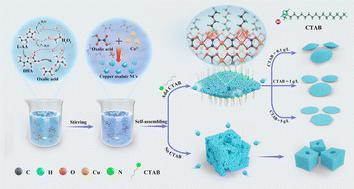Our official English website, www.x-mol.net, welcomes your
feedback! (Note: you will need to create a separate account there.)
CTAB-induced synthesis of two-dimensional copper oxalate particles: using L-ascorbic acid as the source of oxalate ligand
RSC Advances ( IF 3.9 ) Pub Date : 2024-07-23 , DOI: 10.1039/d4ra04181j Bo Shen 1 , Zhengqiu Chen 1 , Huaming Mao 2 , Jungang Yin 2 , Yu Ren 2 , Wei Dai 2 , Shuanglong Zhao 2 , Hongwei Yang 1, 2
RSC Advances ( IF 3.9 ) Pub Date : 2024-07-23 , DOI: 10.1039/d4ra04181j Bo Shen 1 , Zhengqiu Chen 1 , Huaming Mao 2 , Jungang Yin 2 , Yu Ren 2 , Wei Dai 2 , Shuanglong Zhao 2 , Hongwei Yang 1, 2
Affiliation

|
Copper oxalate is typically synthesized through a precipitation reaction involving copper salts mixed with oxalic acid or oxalate solutions. However, in this study, we were successful in synthesizing well-formed square-like copper oxalate particles under liquid-phase conditions at ambient temperature and pressure using ascorbic acid as the source of the oxalic acid ligand. The addition of cationic surfactant cetyltrimethylammonium bromide (CTAB) caused the morphology of copper oxalate particles to undergo a transition from three-dimensional to two-dimensional. And the inhibition of the assembly of primary copper oxalate nanocrystals along the [001] direction became stronger with the increase of CTAB concentration. The impact of CTAB on the crystallization, growth, and self-assembly processes of primary copper oxalate nanocrystals was analysed using various testing methods. Based on these analyses, the possible mechanism of CTAB-induced synthesis of two-dimensional copper oxalate particles was finally proposed.
中文翻译:

CTAB诱导合成二维草酸铜颗粒:以L-抗坏血酸作为草酸配体来源
草酸铜通常通过涉及铜盐与草酸或草酸盐溶液混合的沉淀反应来合成。然而,在这项研究中,我们使用抗坏血酸作为草酸配体的来源,在环境温度和压力的液相条件下成功合成了形状良好的方形草酸铜颗粒。阳离子表面活性剂十六烷基三甲基溴化铵(CTAB)的添加导致草酸铜颗粒的形貌从三维转变为二维。并且随着CTAB浓度的增加,对初生草酸铜纳米晶沿[001]方向组装的抑制作用增强。采用多种测试方法分析了 CTAB 对初生草酸铜纳米晶的结晶、生长和自组装过程的影响。基于这些分析,最终提出了CTAB诱导合成二维草酸铜颗粒的可能机制。
更新日期:2024-07-23
中文翻译:

CTAB诱导合成二维草酸铜颗粒:以L-抗坏血酸作为草酸配体来源
草酸铜通常通过涉及铜盐与草酸或草酸盐溶液混合的沉淀反应来合成。然而,在这项研究中,我们使用抗坏血酸作为草酸配体的来源,在环境温度和压力的液相条件下成功合成了形状良好的方形草酸铜颗粒。阳离子表面活性剂十六烷基三甲基溴化铵(CTAB)的添加导致草酸铜颗粒的形貌从三维转变为二维。并且随着CTAB浓度的增加,对初生草酸铜纳米晶沿[001]方向组装的抑制作用增强。采用多种测试方法分析了 CTAB 对初生草酸铜纳米晶的结晶、生长和自组装过程的影响。基于这些分析,最终提出了CTAB诱导合成二维草酸铜颗粒的可能机制。

































 京公网安备 11010802027423号
京公网安备 11010802027423号